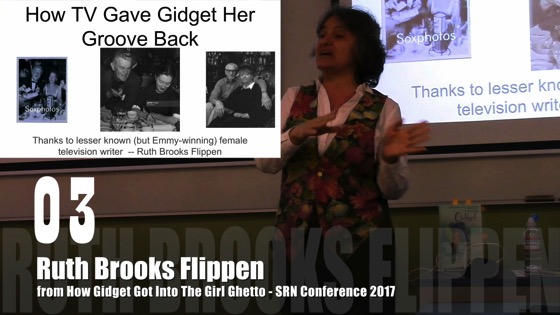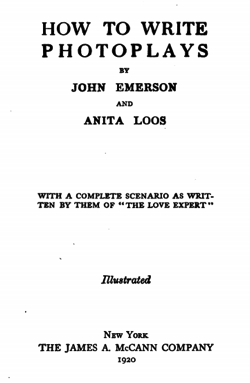Watch this entire presentation
Transcript:
…and it’s because of this woman, Ruth Brooks Flippen, who was the television writer who did the adaptation for television and frankly I had never heard of her. There are a lot of female writers in Hollywood that never get exposure and so this shocked me. Theses are photographs, more likely I was to find her online with her husband because he was an actor in the period. So she is more known as Jay Flippen’s wife than she is as an executive producer for television in her own right and after she got through with Gidget she’s going to do a lot of interesting things. Along the way we’re going to talk about gendered writing and how scripts became different when a man wrote an episode of Gidget versus when a female did, which I did not think would happen and yet it is exactly what I discovered along the way. Sadly, when women write women they give them jobs and make the educated and smart and when men write woman they often don’t give them jobs and they have them shop a lot, which doesn’t seem to suit me as a definition as I really don’t like shopping.
At this year’s 10th Annual Screenwriting Research Network Conference at Otago University in Dunedin, New Zealand I presented…
“How Gidget Got Into the Girl Ghetto by Accident (and How We Can Get Her Out of it): Demoting Gidget: The Little Girl with Big Ideas from Edgy Coming of Age Novel to Babe on the Beach Genre Film via Choices made in the Adaptation Process.”
It’ a long title, as I joke up front, but covers the process of adapting the true life story of Kathy Kohner (nicknamed ‘Gidget’ by the group of male surfers who she spent the summers with in Malibu in the 1950s) into the film and television series that are better remembered than the novel. The novel had been well-received upon publication, even compared to A Catcher in the Rye, but has mistakenly been relegated to the ‘girl ghetto’ of films. Some of the adaptations turned the focus away from the coming of age story of a young woman who gained respect for her talent at a male craft – surfing – and instead turned the focus far too much on Kathy being boy crazy.
Along the way I found interesting comparisons between how female writers treated the main character while adapting the novel and how male writers treated the character.
Dr. Rosanne Welch
Dr. Rosanne Welch teaches the History of Screenwriting and One-Hour Drama for the Stephens College MFA in Screenwriting.
Writing/producing credits include Beverly Hills 90210, Picket Fences, ABCNEWS: Nightline and Touched by an Angel. In 2016 she published the book Why The Monkees Matter: Teenagers, Television and American Pop; co-edited Women in American History: A Social, Political, and Cultural Encyclopedia; and placed “Transmitting Culture Transnationally Via the Characterization of Parents in Police Procedurals” in the New Review of Film and Television Studies. Essays appear in Torchwood Declassified: Investigating Mainstream Cult Television and Doctor Who and Race: An Anthology. Welch serves as Book Reviews editor for Journal of Screenwriting and on the Editorial Advisory Board for Written By magazine, the magazine of the Writers Guild.
Watch Dr. Welch’s talk “The Importance of Having a Female Voice in the Room” at the 2016 TEDxCPP.
The Screenwriting Research Network is a research group consisting of scholars, reflective practitioners and practice-based researchers interested in research on screenwriting. The aim is to rethink the screenplay in relation to its histories, theories, values and creative practices.
Podcast: Play in new window | Download
Subscribe: RSS




![Frances Goodrich and Albert Hackett from Giving Voice to Silent Films and the Far From Silent Women Who Wrote Them with Dr. Rosanne Welch [Video]](https://rosannewelch.com/wp-content/uploads/2018/01/ufva-14-hacketts.jpeg)








![The “Capra Touch” and Writers from Giving Voice to Silent Films and the Far From Silent Women Who Wrote Them with Dr. Rosanne Welch [Video]](https://rosannewelch.com/wp-content/uploads/2018/01/ufva-13-capra-touch.jpeg)





![02 How TV Gave Gidget Her Groove Back from How Gidget Got Into the Girl Ghetto – Dr. Rosanne Welch – SRN Conference 2017 [Video]](https://rosannewelch.com/wp-content/uploads/2017/12/gidget-srn-02.jpeg)

![Writers Have Been Lost In Film History from Giving Voice to Silent Films and the Far From Silent Women Who Wrote Them with Dr. Rosanne Welch [Video]](https://rosannewelch.com/wp-content/uploads/2017/12/ufva-12-forgotten-writers.jpeg)



![01 Introduction from How Gidget Got Into the Girl Ghetto – Dr. Rosanne Welch – SRN Conference 2017 [Video]](https://rosannewelch.com/wp-content/uploads/2017/10/gidget-srn.png)